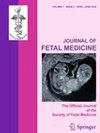The Impact of Isolated Increased Nuchal Translucency ≥95th Centile on Perinatal Outcome: A Prospective Cohort Study from a North Indian Genetic Center
IF 0.2
Q4 OBSTETRICS & GYNECOLOGY
引用次数: 0
Abstract
Abstract Objectives The aim of this study was to determine the chromosomal abnormalities and other adverse outcomes like miscarriages, intrauterine deaths, structural defects, and genetic syndromes in fetuses with increased nuchal translucency (NT) more than or equal to 95th centile. This study also compared the outcomes in fetuses with NT between 95th and 99th centile and more than 99th centile. Study Design A prospective cohort of 182 patients with isolated increased NT was evaluated by invasive testing. Fetal chromosomes were examined by fluorescent in situ hybridization and karyotype or chromosomal microarray. Euploid pregnancies were followed-up with level II ultrasound and fetal echocardiography. For pregnancies progressing to delivery, the neonates were followed-up till the age of 3 months. Final outcome was reported as normal or abnormal. Collated data for perinatal outcomes was analyzed and compared between fetuses with NT 95th and 99th centile (group I) and NT more than 99th centile (group II). Results Of the 202 patients recruited, 182 patients consented for invasive testing and chromosomal analysis. Of the 182 patients, group I (NT 95–99th centile ) included 92 patients and group II 90 patients. Chromosomal abnormalities were present in 50 (27.4%), 14 (7.6%) in group I, and 36 (19.4%) in group II. Of the 132 euploid pregnancies, adverse outcomes were present in 22 (16%) fetuses, 7 (5.3%) in group I, and 15(11.7%) in group II. A normal outcome was present in 110 (60.4%) pregnancies of the 182 fetuses with NT more than or equal to 95th centile. Normal outcome observed in group I was 77.1% and in group II, it was 43.4%. Conclusion An increased NT is associated with poor perinatal outcomes in 39.6% patients. Chromosomal analysis and follow-up for adverse outcome in fetuses with NT more than or equal to 95th centile is important to enable a take home neonatal rate of 60.4%. No pregnancy with increased NT should be discontinued without detailed fetal evaluation for genetic disorders, structural malformation, and fetal growth.北印度遗传中心的一项前瞻性队列研究:≥95百分位单独增加颈部透明度对围产期结局的影响
摘要目的本研究的目的是确定颈透性(NT)增加超过或等于95百分位的胎儿的染色体异常和其他不良结局,如流产、宫内死亡、结构缺陷和遗传综合征。本研究还比较了95 - 99百分位和超过99百分位的NT胎儿的结局。研究设计:对182例孤立性NT增高患者进行前瞻性队列研究,采用侵入性检测进行评估。采用荧光原位杂交和染色体微阵列检测胎儿染色体的核型。整倍体妊娠随访II级超声和胎儿超声心动图。对妊娠至分娩的新生儿进行随访,直至3个月。最终结果报告为正常或异常。收集整理的围产期结局数据,并对NT第95和99百分位(I组)和NT超过99百分位(II组)的胎儿进行分析和比较。结果在招募的202例患者中,182例患者同意进行侵入性检查和染色体分析。182例患者中,I组(NT 95 - 99百分位)包括92例患者,II组包括90例患者。染色体异常50例(27.4%),ⅰ组14例(7.6%),ⅱ组36例(19.4%)。在132例整倍体妊娠中,22例(16%)胎儿出现不良结局,1组7例(5.3%),2组15例(11.7%)。在182例NT≥95百分位的胎儿中,110例(60.4%)妊娠结局正常。ⅰ组和ⅱ组的正常转归率分别为77.1%和43.4%。结论39.6%的患者NT升高与围产儿预后不良相关。染色体分析和对NT大于或等于95百分位的胎儿不良结局的随访对于使新生儿带回家率达到60.4%很重要。在对遗传疾病、结构畸形和胎儿生长进行详细的胎儿评估之前,不应停止NT增高的妊娠。
本文章由计算机程序翻译,如有差异,请以英文原文为准。
求助全文
约1分钟内获得全文
求助全文
来源期刊

Journal of Fetal Medicine
OBSTETRICS & GYNECOLOGY-
自引率
50.00%
发文量
26
期刊介绍:
Journal of Fetal Medicine is the official journal of the Society of Fetal Medicine affiliated with International Society of Ultrasound in Obstetrics & Gynecology. This is a peer-reviewed international journal featuring articles with special interest to fetal medicine specialists, geneticists and ulstrasonologists. The aim of the journal is to communicate the results of original research in the field of fetal medicine. It includes a variety of articles suitable for clinicians and scientific specialists concerned with diagnosis and therapy of fetal disorders. All articles on health promotion of the fetus are acceptable for publication. The major focus is on highlighting the work that has been carried out in India and other developing countries. It also includes articles written by experts from the West. Types of articles published: - Original research articles related to fetal care and basic research - Review articles - Consensus guidelines for diagnosis and treatment - Case reports - Images in Fetal Medicine - Brief communications
 求助内容:
求助内容: 应助结果提醒方式:
应助结果提醒方式:


